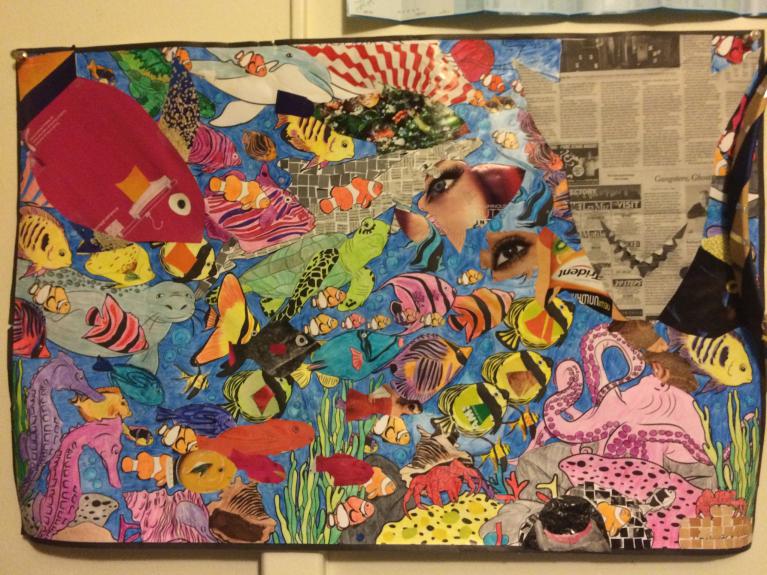April 6, 2015 - 20:32

Children are captivated with picture books and coloring books from the very beginning of life. It was not uncommon for children’s books to be composed of only a couple of words, or sometimes even no words. Before children learn to read and write words and phrases, they are introduced to coloring books. I remember sitting down at the kitchen table, my two older sisters hovering over me emphasizing to me the importance of staying within the lines, keeping the lines sharp and never putting too much of just one color. To this day, I use these guidelines when I am coloring anything, and coloring anything happens quite often for me.
I find coloring very therapeutic, probably because not much brain power is needed. The rules are so set in stone that there is no need to make decisions, just following a routine. Earlier in the semester I found a giant coloring poster at 5 Below and jumped at the idea of it. As soon as I saw it, I was hooked; I have been coloring it in since the middle of October. It was nice to have something outlined already, and ready for me to delve into. I especially love the fact that it is not Disney princesses or anything too famous or else I would be consumed trying to match the colors perfectly to the read picture. It is nice to be able to do something where not too much thinking beyond “what should the next color be?” is involved. By coincidence, my mom sent me an audio which aired on NPR this past week, Artist Goes outside the Lines with Coloring Books for Grown-Ups, and as it turns out, there are many people like myself who find coloring therapeutic, which I sort of expected.
Coloring inside the lines is therapeutic, likely because it is so engrained; there is not much need to think about whether or not the technique should be practiced. In this project, I tried to challenge the idea of what was comfortable coloring. In addition to using crayons, I also used markers, streamers, newspaper, tape, glue, magazines, the list goes on. I want to make the act of filling in the lines as uncomfortable as possible, while still keeping the piece cohesive. I chose to make fish out of eye balls in magazines, draw in a hidden mermaid (can you see it? It is pretty big), make a shark dive through the water. When I first began making myself uncomfortable, I found myself cutting out squares and decorating the poster by filling in the poster with mosaic tiles. I quickly realized that this technique would take far too long, so I tried various other techniques including cutting out magazines, added 3D components with jut outs. Seeing as the poster took me nearly 5 months to get 1/10 of it done, I had a few friends come help me out. They definitely don't enjoy coloring as much as me and were very confused how this could be an english project. When I explained that I was trying to make myself uncomfortable by challenging a structure that is so engrained in me, they still didn't seem to get it. Instead of handing them crayons and markers I gave them scissors and glue. Being the perfectionist that I am, I had to forgo the idea that the poster was going to be colored how I originally expected. Despite this fact, I am tremendously pleased with how it came out, despite the fact that it was painful not doing it the way I had intended.
Before this weekend,

After this weekend,


Comments
Color Therapy
Submitted by Anne Dalke on April 11, 2015 - 14:12 Permalink
Purple Finch--
So, as you might imagine, I’m smiling broadly here @ your act of “uncomfortable coloring,” @ your need to call in your coloring-phobic friends to get this project done on deadline, and (most of all!) your eventually letting go of your original ideas of how the poster would “come out.”
You end your account by saying that you are “tremendously pleased” with the final product, but I want to know more, much more: what pleased you? What was worth the pain? What are the presumptions underlying perfectionism that got unsettled in this project?
More pointedly: how does this exercise contribute to our discussion, over the past few weeks, about challenging normative modes of representation? We’ve been playing with mixing up language, replacing the conventional subject-object-verb sequence with intransitive forms, nouns with verbs, root verb forms with progressive (“ing) ones…do you also see these linguistic acts as forms of “coloring outside the lines”? Is coloring “purely” metaphoric, or also analytic? What is the “critical making” inherent in this act of transgression and creativity?
You have of course not only violated your sisters’ strict instructions to stay within the lines, but also 16 years of schooling that asked you to follow directions, to master conventional forms of showing that you’ve learned the subjects you’ve been instructed in….so what has happened, in this process, to the traditional analytic paper?
My final question has to do with how you understand what happened here in relation to last month’s project, in which you researched documentaries (and—I wasn’t sure?—queried your own viewing habits). Are you on a path here to deny yourself all your conventional pleasures….? To discuss!
Also: I haven’t been able to pick out the mermaid….